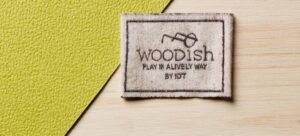The fashion industry faces increasing scrutiny over its environmental impact. From textile production to garment waste, each stage of the clothing lifecycle contributes significantly to pollution and environmental degradation. In response, many brands are adopting more sustainable practices, and one of these practices is the use of biodegradable materials in clothing labels.
What does it mean that a material is biodegradable?
Biodegradable materials are those that can decompose naturally in the environment without leaving toxic residues. These materials decompose thanks to the action of microorganisms such as bacteria and fungi, and eventually become simple compounds that can be assimilated by nature. Key characteristics of these materials include their rapid decomposition ability, non-toxicity, and renewable origin.

Biodegradable materials used in eco-friendly labels
Recycled polyester
Recycled polyester is made from recycled plastic bottles and other plastic waste. It offers a sustainable alternative to virgin polyester, as it reduces the need for new raw materials and reduces plastic waste in the environment. Labels made from recycled polyester are durable and can withstand the wear and tear associated with everyday clothing use.
Plantable paper
Plantable paper is an innovative material that contains seeds embedded in its structure. Once the tag has served its purpose, it can be planted in the ground, where a plant will germinate and grow. This type of paper is not only biodegradable, but also contributes to biodiversity and waste reduction.
Forest-based compostables
Compostable materials of forest origin, such as certain types of paper and cardboard, decompose completely in proper composting. These materials come from sustainably managed forests and offer an eco-friendly alternative to traditional plastics. Labels made from compostable materials can be disposed of with organic waste, where they will decompose and enrich the soil.
Sugar cane
Sugar cane is a renewable resource that can be used to manufacture biodegradable bioplastics. These bioplastics decompose more quickly than conventional plastics and have a lower environmental impact. Labels made from sugar cane are durable and can be designed to meet various textile industry specifications.
Cotton and linen from controlled crops
Controlled cotton and flax are produced sustainably, using agricultural practices that minimize the use of pesticides and chemical fertilizers. These natural materials are biodegradable and soft to the touch, making them ideal for eco-friendly clothing labels. Its controlled production ensures a smaller environmental footprint and greater sustainability.

100% recyclable Tyvek
Tyvek is an extremely strong and durable synthetic material, and its 100% recyclable version offers a sustainable option for clothing labels. It is lightweight, water-resistant, and tear-resistant, making it ideal for labels that require durability.
Stone paper
Stone paper is an innovative material composed of 70%-80% common limestone powder and 20%-30% polyethylene. This synthetic paper is completely recyclable and offers a sustainable alternative to traditional papers. It is water and tear resistant, and its production has a lower environmental impact compared to conventional paper.
There are other materials that are being used for sustainable labels, such as:
- Recycled paper, which contributes to reducing deforestation and the consumption of natural resources.
- Cannabis paper, made from hemp fibers, a sustainable and resistant option at the same time.
- Grass paper: Uses grass fibers, which reduces the consumption of water and chemicals in its production.
- Rice paper: Produced from rice crop residues, it is an innovative and sustainable option.
Seed paper: Contains embedded seeds that allow the label to be planted after use. - Seed paper: Contains embedded seeds that allow the label to be planted after use.

What are the benefits of using biodegradable materials in clothing labels?
Obviously, the use of biodegradable materials in clothing labels contributes significantly to reducing environmental impact. These materials decompose without releasing toxic substances, which helps preserve ecosystems and reduce pollution.
Additionally, consumers are increasingly aware of the environmental impact of their purchases and tend to prefer brands that demonstrate a commitment to sustainability. The use of biodegradable labels can improve brand perception and appeal to an environmentally conscious market segment.
In conclusion, the use of biodegradable materials in clothing labels represents a significant step towards sustainability in the fashion industry. But we haven’t reached the end of the road. The future of biodegradable clothing labels is promising, with many emerging innovations in materials and design. We are sure that new biodegradable materials will continue to be developed that are even more efficient and ecological.




